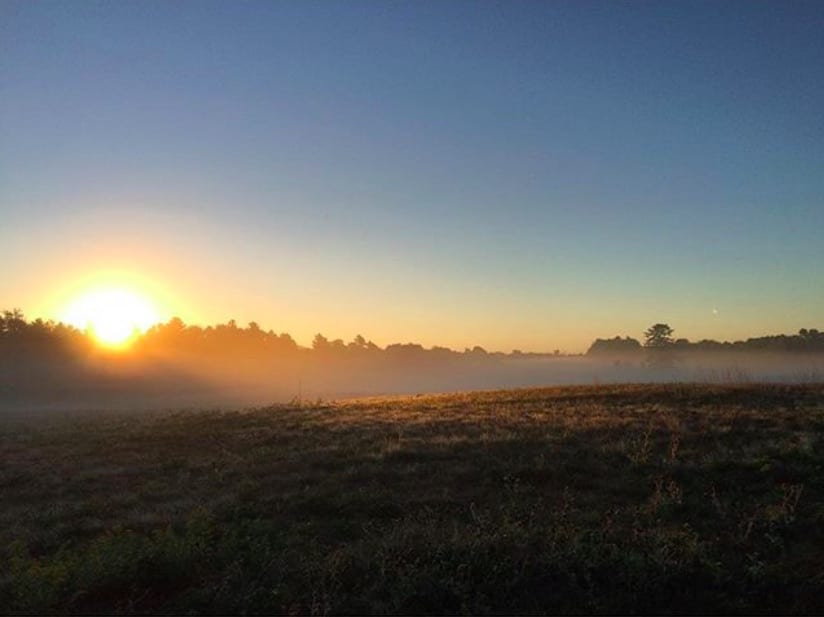Main Menu
Running for Chronic Pain Management

Laura Overton is in the early stages of her running career, racing primarily in Maine and Vermont. Off the trails, she is a public health practitioner, yoga teacher, amateur birder, and avid reader, with a curious mind and a hunger for movement.
Share This Article!


By: Laura Overton
I crouch down to pick up my socks from the floor, and am paralyzed with pain so severe that I can’t breathe. I can’t stand up, and I let an involuntary gasp out into the darkness. I reach for the wall to hold onto as I start to panic, though I have been through this enough times to know that this feeling will pass in a few moments. I am conscious of my partner sleeping just a few feet away, on the other side of a poorly insulated wall. I want to call to him, but know there is nothing he can do to help. There is a feeling of utter aloneness as I convince myself not to wake him up. It’s the type of aloneness that every human being who has ever been sick or in pain knows well. Slowly, I regain my breath. It is shallow at first, then deeper as I feel my body relax. I wonder if I can make it outside for a run.
 I creep quietly down the stairs, and eye the coffee maker warily. Should I skip it? I could drink green tea…Dr. Noble said green tea was a better choice for so many reasons. I don’t want to drink green tea. I want a cup of goddamn coffee. It’s not like I am going to drink the whole pot.
I creep quietly down the stairs, and eye the coffee maker warily. Should I skip it? I could drink green tea…Dr. Noble said green tea was a better choice for so many reasons. I don’t want to drink green tea. I want a cup of goddamn coffee. It’s not like I am going to drink the whole pot.
I eventually get out the door and start to slowly move my body through the neighborhood, and into the woods. Every quarter mile or so, I stop and check in with myself: How do I feel? Can I keep going? I notice that as I move I start to feel my insides unwind, and I soon feel lighter with the realization that nothing hurts.
 I have endometriosis, a chronic condition that is thought to affect roughly 1 in 10 women worldwide. In a healthy woman endometrial tissue lines the uterus, and this tissue responds to a woman’s natural cycle, thickening and shedding, leaving the body in the form of a period. Endometriosis occurs when endometrial tissue grows elsewhere in the body, often latching on to other reproductive organs or intestines. This tissue reacts the same way to a woman’s cycle, building up, and then breaking down and bleeding. Unlike the cells in the uterus that leave the body as a period, this blood has no way to leave, and builds scar tissue on the organs it is attached to (reworded from a brochure that must have come from the ‘90s). It undeniably is a painful condition, and can be debilitating for many. It can go undiagnosed, or misdiagnosed, for years, damaging the female reproductive system, sometimes resulting in infertility. There is not a real understanding of why it happens, nor is there a cure. Few treatment options are available, and none are guaranteed to work.
I have endometriosis, a chronic condition that is thought to affect roughly 1 in 10 women worldwide. In a healthy woman endometrial tissue lines the uterus, and this tissue responds to a woman’s natural cycle, thickening and shedding, leaving the body in the form of a period. Endometriosis occurs when endometrial tissue grows elsewhere in the body, often latching on to other reproductive organs or intestines. This tissue reacts the same way to a woman’s cycle, building up, and then breaking down and bleeding. Unlike the cells in the uterus that leave the body as a period, this blood has no way to leave, and builds scar tissue on the organs it is attached to (reworded from a brochure that must have come from the ‘90s). It undeniably is a painful condition, and can be debilitating for many. It can go undiagnosed, or misdiagnosed, for years, damaging the female reproductive system, sometimes resulting in infertility. There is not a real understanding of why it happens, nor is there a cure. Few treatment options are available, and none are guaranteed to work.
No woman in my family ever talked about periods. They are not a thing to be celebrated in my culture, nor were they something to be asked questions about. I learned about breasts and periods from a book called, “What’s Happening to My Body: Book for Girls.” My mother gave it to me on New Year’s Eve when she and my father left for dinner. I stayed home that night looking at pictures, wondering if my breasts were going to look like the ones in the “Stage 4” drawing, definitely hoping they would. (They never did.) By giving me a book, my mother probably did more for me than her mother did for her. It’s just how it was in my family.
As I got older, I imagined that things I went through every month were “part of being a woman” and normalized it in my mind. I thought chronic fatigue happened to everyone who was as active as I was, especially when doctors did blood tests and told me nothing was wrong. They advised me that I may feel better if I just rest, if I just stop burning the candle at both ends, if I just slow down. I spent a day in the Emergency Room in my early twenties being examined by three different doctors. I left with a misdiagnosis, antibiotics that I didn’t need, and the cautionary words of, “You will probably feel better if you get some rest and lay low for a while.” I went home and put on my sneakers, telling myself that a walk was going to make me feel better. I ended up tearing through the woods, on one of the best runs I had had in a while, feeling the most well that I had felt all day. It was both a lesson in understanding our medical system fails us all of the time, and in the importance of listening to my body.
 As women we know that we feel differently depending where in our cycle we are. Maybe we are more tired when we are ovulating, and understand to give our bodies a rest at that time. Maybe we have the best race results the day before our period starts, or maybe that is the time of month when we can’t seem to keep our eyes open. Some of us are so regular, it makes training and racing easy to schedule, some of us have no idea what mother nature has in store for us each month. As far as endometriosis goes, I know I am one of the lucky ones, for my condition is not nearly as painful or severe has I have heard from other women. I appreciate that going for a run often brings pain relief, and know that the more time I spend sitting the worse I feel. I do, however, have days where I know upon waking up that moving my body is just not going to be possible, and I do my best to honor that.
As women we know that we feel differently depending where in our cycle we are. Maybe we are more tired when we are ovulating, and understand to give our bodies a rest at that time. Maybe we have the best race results the day before our period starts, or maybe that is the time of month when we can’t seem to keep our eyes open. Some of us are so regular, it makes training and racing easy to schedule, some of us have no idea what mother nature has in store for us each month. As far as endometriosis goes, I know I am one of the lucky ones, for my condition is not nearly as painful or severe has I have heard from other women. I appreciate that going for a run often brings pain relief, and know that the more time I spend sitting the worse I feel. I do, however, have days where I know upon waking up that moving my body is just not going to be possible, and I do my best to honor that.
My hope is that in writing this, women who also may have endometriosis feel that they aren’t alone. Perhaps some will now understand severe pain with periods may not be normal, or maybe if you’ve never heard of endometriosis, now you have. For a disease that is so common, we live in a country that drastically underfunds treatment and research.
Though movement is not always possible for some, I would recommend exercise to anyone who suffers from endometriosis who feels able enough to get out into the woods, into the water, onto a yoga mat, or to a preferred place.
About the Author

Laura Overton is in the early stages of her running career, racing primarily in Maine and Vermont. Off the trails, she is a public health practitioner, yoga teacher, amateur birder, and avid reader, with a curious mind and a hunger for movement.
Share This Article!












2 Responses
I also run to manage endometriosis. I was diagnosed in 1994 after a decade of symptoms & misdiagnosis. I always exercised but wasn’t a runner. I loved mountain biking & hiking trails so decided to try trail running in 2014, then on a whim signed up for a road half marathon in April 2015. I had never run a race in my life & was only trained up to 7 miles. Something wonderful happened in the weeks to follow that race. I noticed my chronic pelvic pain was missing. The more I ran, the less I felt. I trail run all the time now & hardly think about the pain from the endometriosis or my scars from 5 pelvic surgeries! I still occasionally feel a few pings & pangs, usually when I haven’t been able to run. I completed my second 50k trail ultra this May 2018! Just. Keep. Running.
I really needed to see this today! Thank you so much for sharing your story. I’ve struggled with endometriosis since I was 17 and I’m trying to slowly get back into exercise since the addition of lupus to my autoimmune mess. I’m so interested in the mental clarity that I know running brings, but I am oftentimes crippled by pain and then the anxiety of when the pain break through can be unbearable. It sounds like even if it’s just a few blocks, putting my sneakers on again and trying is what really counts. Who knows? It might really help my pain issues! I’m willing to do anything. Thank you again for sharing – it resonated with me on a spiritual level.